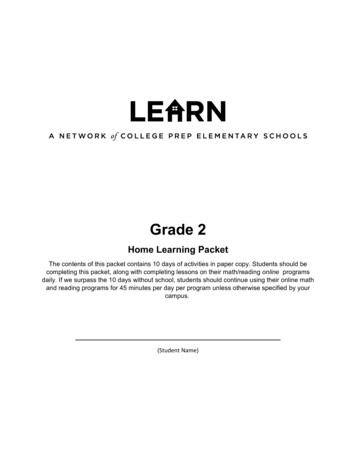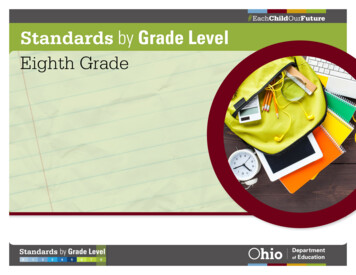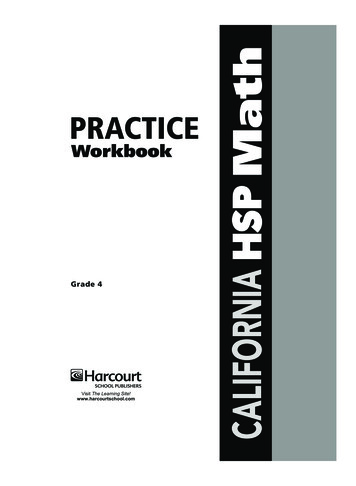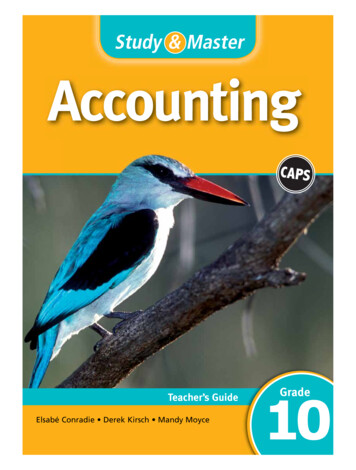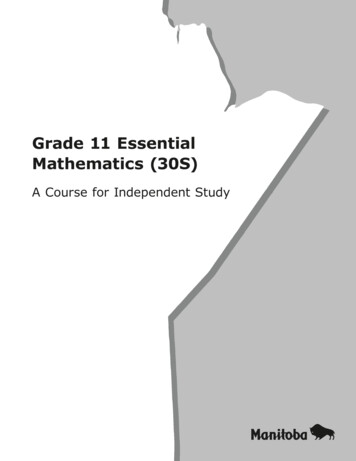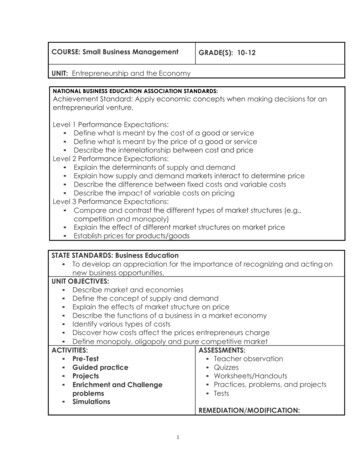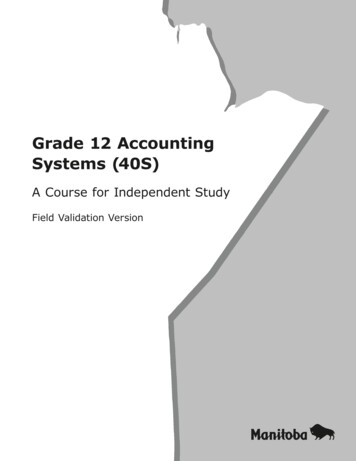
Transcription
Grade 12 AccountingSystems (40S)A Course for Independent StudyField Validation Version
Gr ade 12 AccountingS y s t e m s (4 0 S )A Course for Independent StudyField Validation Version2017M a ni t o b a E d u c a t i o n a n d Tr ainin g
Manitoba Education and Training Cataloguing in Publication DataGrade 12 accounting systems (40S) : a course for independentstudy—Field validation versionThis resource is available in print and electronic formats.ISBN: 978-0-7711-7531-2 (print)ISBN: 978-0-7711-7532-9 (pdf)1. Accounting—Study and teaching (Secondary).2. Accounting—Study and teaching (Secondary)—Manitoba.3. Accounting—Programmed instruction.4. Distance education—Manitoba.5. Correspondence schools and courses—Manitoba.I. Manitoba. Manitoba Education and Training.657Copyright 2017, the Government of Manitoba, represented by the Ministerof Education and Training.Manitoba Education and TrainingWinnipeg, Manitoba, CanadaEvery effort has been made to acknowledge original sources and to complywith copyright law. If cases are identified where this has not been done, pleasenotify Manitoba Education and Training. Errors or omissions will be correctedin a future edition. Sincere thanks to the authors, artists, and publishers whoallowed their original material to be usedAll images found in this resource are copyright protected and should notbe extracted, accessed, or reproduced for any purpose other than for theirintended educational use in this resource.Any websites referenced in this resource are subject to change without notice.Educators are advised to preview and evaluate websites and online resourcesbefore recommending them for student use.Available in alternate formats upon request.
hat Will You Learn in This Course?3How Is This Course Organized?3What Resources Will You Need for This Course?5Who Can Help You with This Course?6How Will You Know How Well You Are Learning?7How Much Time Will You Need to Complete This Course?9When and How Will You Submit Completed Assignments?11What Are the Guide Graphics For?13Module Cover Sheets151Module 1: Accounting Principles ReviewIntroduction3Lesson 1: Accounting Concepts Review5Lesson 2: The Accounting Cycle (Part 1)13Lesson 3: The Accounting Cycle (Part 2)51Assignment 1.1: Completing the Accounting Cyclefor a Service Business63Module 1 Summary731Learning Activity Answer KeyContentsiii
Module 2: Merchandising FirmsIntroduction3Lesson 1: Introduction to Accounting for Merchandising Firms5Lesson 2: Selling Merchandise15Lesson 3: Purchasing Inventory33Lesson 4: The Income Statement for a Merchandising Business43Lesson 5: Inventory Valuation51Assignment 2.1: The Periodic Inventory System57Module 2 Summary63Learning Activity Answer KeyModule 3: Merchandising Firms: The Perpetual Inventory System11Introduction3Lesson 1: Introduction to the Perpetual Inventory System5Lesson 2: Selling Merchandise13Lesson 3: Purchasing Inventory29Assignment 3.1: The Perpetual Inventory System43Module 3 Summary49Learning Activity Answer KeyModule 4: Special Journals11Introduction3Lesson 1: The Purchases Journal5Lesson 2: The Sales Journal19Lesson 3: The Cash Receipts Journal31Lesson 4: The Cash Payments Journal45Assignment 4.1: Using the Special Journal System61Module 4 Summary65Learning Activity Answer Keyiv1Grade 12 Accounting Systems1
1Module 5: Adjusting EntriesIntroduction3Lesson 1: Basic Adjustments5Lesson 2: Adjusting Bad Debts23Lesson 3: Adjusting for Accruals35Lesson 4: Adjusting for Unearned and Unrecorded Revenue47Assignment 5.1: Advanced Adjustments57Module 5 Summary61Learning Activity Answer Key1Module 6: Completing the Accounting Cycle1Introduction3Lesson 1: Completing the Worksheet and Updating theInventory Account5Lesson 2: Preparing the Financial Statements15Lesson 3: Journalizing Adjusting and Closing Entries29Lesson 4: Completing the Accounting Cycle53Assignment 6.1: Completing the Accounting Cycle for aMerchandising Business69Module 6 Summary711Learning Activity Answer Key1Module 7: Accounting in ActionIntroduction3Lesson 1: Introduction to Financial Analysis5Lesson 2: Introduction to Corporate Accounting29Lesson 3: Careers in Accounting41Assignment 7.1: Financial Analysis and Accounting as a Career49Module 7 Summary571Learning Activity Answer KeyContentsv
viGrade 12 Accounting Systems
AcknowledgementsManitoba Education and Training gratefully acknowledges the contributions of the followingindividuals in the development of Grade 12 Accounting Systems (40S): A Course for IndependentStudy, Field Validation Version.WriterContent ReviewerDevelopmentTeam MembersManitoba Educationand TrainingStaffAngela BaraniukDakota CollegiateLouis Riel School DivisionSusana HawryshkoGarden Valley CollegiateGarden Valley School DivisionJohn FroeseDaniel McIntyre Collegiate InstituteWinnipeg School DivisionMonica GadsbyWest Kildonan CollegiateSeven Oaks School DivisionWill HabingRiver East CollegiateGarden Valley School DivisionSusana HawryshkoGarden Valley CollegiateGarden Valley School DivisionSharon McRaeVincent Massey CollegiatePembina Trails School DivisionCarole BilykCoordinator(until June 2016)Development UnitInstruction, Curriculum and Assessment BranchLouise BoissonneaultCoordinatorDocument Production Services UnitEducational Resources BranchDiane CourcellesPublications EditorDocument Production Services UnitEducational Resources BranchLynn HarrisonDesktop PublisherDocument Production Services UnitEducational Resources BranchMyrna KlassenActing CoordinatorDistance Learning UnitInstruction, Curriculum and Assessment BranchGilles LandryProject ManagerLearning Support and Technology UnitInstruction, Curriculum and Assessment BranchDan LemieuxProject LeaderLearning Support and Technology UnitInstruction, Curriculum and Assessment BranchAcknowledgementsvii
Gr ade 12 AccountingS y s t e m s (4 0 S )Introduction
IntroductionOverviewWelcome to Grade 12 Accounting Systems. In this course, you will beintroduced to accounting for a merchandising business where you will learnhow to complete the accounting procedures under both the periodic andperpetual inventory systems. Students interested in a career in accountingor finance, or students who may one day own their own business, areencouraged to take this course.As a student enrolled in a distance learning course, you have taken on a dualrole—that of a student and a teacher. As a student, you are responsible formastering the lessons and completing the learning activities and assignments.As a teacher, you are responsible for checking your work carefully, notingareas in which you need to improve and motivating yourself to succeed.What Will You Learn in This Course?In this course, you will learn how to process business transactions that dealwith merchandise inventory (items you plan to resell) in order to understandthe unique relationship between sales and cost of goods sold. You will alsolearn how to move beyond the General Journal and use a five journal orSpecial Journal system. Advanced adjustments and financial analysis willalso be covered. Ultimately, you will learn how to “complete the books” for amerchandising business.How Is This Course Organized?The Grade 12 Accounting Systems course consists of the followingseven modules:QQModule 1: Accounting Principles ReviewQQModule 2: Merchandising FirmsQQModule 3: Merchandising Firms: The Perpetual Inventory SystemQQModule 4: Special JournalsQQModule 5: Adjusting EntriesQQModule 6: Completing the Accounting CycleQQModule 7: Accounting in ActionIntroduction3
Each module in this course consists of several lessons, which contain thefollowing components:QQQQQQQQQQQQ4Lesson Focus: The Lesson Focus at the beginning of each lesson identifiesone or more specific learning outcomes (SLOs) that are addressed inthe lesson. The SLOs identify the knowledge and skills you should haveachieved by the end of the lesson.Introduction: The Introduction gives an explanation of what you will belearning in that lesson.Lesson: The main body of the lesson is made up of the content that you needto learn. It contains text, explanations, images, and diagrams.Learning Activities: Most lessons include one or more learning activitiesthat will help you learn about the lesson topics and prepare you for theassignments and the final examination. Once you complete a learningactivity, check your responses against those provided in the LearningActivity Answer Key found at the end of each module. You will not submitthe completed learning activities to your tutor/marker.Assignments: Assignments are found at the end of each module. You willmail or electronically submit all your completed assignments to your tutor/marker for assessment at the end of each module. In total, all assignmentsare worth 75 percent of your final course mark.Summary: Each lesson ends with a brief review of what you just learned.Grade 12 Accounting Systems
What Resources Will You Need for This Course?You do not need a textbook for this course. All the content is provided directlywithin the course. You will, however, need access to a variety of resources.You will require access to an email account if you plan toQQcommunicate with your tutor/marker by emailQQuse Blackboard Learn to submit completed assignmentsA valid email account is required for your Blackboard Learn profile. Thewebsite address for Blackboard Learn is https://bblearn.merlin.mb.ca. Youwere issued a username and password when you registered for this course.The required and optional resources for this course are identified below.Required ResourcesFor this course, you will need the following electronic resource(s). If you donot have access to the Internet, or if you need a copy of the resource(s), contactthe Distance Learning Unit at 1-800-465-9915.nMicrosoft Excel Files: Throughout this course, you will need Excel datafiles to complete the learning activities, the assignments, and the finalexamination. These files are available on Blackboard Learn athttps://bblearn.merlin.mb.ca. If you do not have access to the Internet, or ifyou need a copy of the files, contact the Distance Learning Unit at1-800-465-9915.Optional ResourcesIt would be helpful if you had access to the following resources.nnPrinter: With access to a printer, you could make a copy of your assignmentsbefore submitting them so that if your tutor/marker wants to discuss anassignment with you over the phone, each of you will have a copy. It wouldalso allow you to continue studying or to complete further lessons whileyour original work is with the tutor/marker. Printing your assignments willalso ensure that you keep a copy in case the originals are lost.Calculator: Access to a calculator would be beneficial.Introduction5
Who Can Help You with This Course?Taking an independent study course is different from taking a course in aclassroom. Instead of relying on the teacher to tell you to complete a learningactivity or an assignment, you must tell yourself to be responsible for yourlearning and for meeting deadlines. There are, however, two people who canhelp you be successful in this course: your tutor/marker and your learningpartner.Your Tutor/MarkerTutor/markers are experienced educators who tutor ISO students andmark assignments and examinations. When you are having difficulty withsomething in this course, contact your tutor/marker, who is there to help you.Your tutor/marker’s name and contact information were sent to you with thiscourse. You can also obtain this information in the Who Is My Tutor/Marker?section of the distance learning website at www.edu.gov.mb.ca/k12/dl/iso/assistance.html.Your Learning PartnerA learning partner is someone you choose who will help you learn. It may besomeone who knows something about accounting, but it doesn’t have to be. Alearning partner could be someone else who is taking this course, a teacher,a parent or guardian, a sibling, a friend, or anybody else who can help you.Most importantly, a learning partner should be someone with whom you feelcomfortable and who will support you as you work through this course.Your learning partner can help you keep on schedule with your coursework,read the course with you, check your work, look at and respond to yourlearning activities, or help you make sense of assignments. You may evenstudy for your examination(s) with your learning partner. If you and yourlearning partner are taking the same course, however, your assignment workshould not be identical.6Grade 12 Accounting Systems
How Will You Know How Well You Are Learning?You will know how well you are learning in this course by how well youcomplete the learning activities, assignments, and examination.Learning ActivitiesThe learning activities in this course will help you to review and practisewhat you have learned in the lessons. You will not submit the completedlearning activities to your tutor/marker. Instead, you will complete thelearning activities and compare your responses to those provided in theLearning Activity Answer Key found at the end of each module.Make sure you complete the learning activities. Doing so will not only helpyou to practise what you have learned, but will also prepare you to completeyour assignments and the examination successfully. Many of the questionson the examination will be similar to the questions in the learning activities.Remember that you will not submit learning activities to your tutor/marker.AssignmentsEach module in this course contains assignments, which you will completeand submit to your tutor/marker for assessment. The assignments are worth atotal of 75 percent of your final course mark.The tutor/marker will mark your assignments and return them to you.Remember to keep all marked assignments until you have finished the courseso that you can use them to study for your examination.Final ExaminationThis course contains a final examination.QQThe final examination is based on Modules 1 to 7, and is worth 25 percentof your final mark in this course. You will write the final examination whenyou have completed Module 7.You will write the final examination under supervision.Introduction7
How to Study for Your ExaminationTo do well on your examination, you should review all the work youhave completed from the modules, including all learning activities andassignments.The questions on the examination are set up exactly like the learningactivities and the assignments. In other words, you will be asked to do thesame tasks on three separate occasions—on the learning activities, on theassignments, and on the examination.Requesting Your ExaminationYou are responsible for making arrangements to have the examination sentto your proctor from the Distance Learning Unit. Please make arrangementsbefore you finish Module 7 to write the final examination.To write your examination, you need to make the following arrangements:nnIf you are attending school, your examination will be sent to your schoolas soon as all the applicable assignments have been submitted. You shouldmake arrangements with your school’s ISO school facilitator to determine adate, time, and location to write the examination. For more information onexamination procedures, please contact your ISO school facilitator or visitthe Grading and Evaluation section of the distance learning website atwww.edu.gov.mb.ca/k12/dl/iso/assignments.html.If you are not attending school, check the Examination Request Formfor options available to you. The form was mailed to you with this course.Three weeks before you are ready to write the examination, fill in theExamination Request Form and mail, fax, or email it toDistance Learning Unit500–555 Main StreetPO Box 2020Winkler MB R6W 4B8Fax: 1-204-325-1719Toll-Free Telephone: 1-800-465-9915Email: distance.learning@gov.mb.ca8Grade 12 Accounting Systems
How Much Time Will You Need to Complete This Course?Learning through independent study has several advantages over learningin the classroom. You are in charge of how you learn and you can choosehow quickly you will complete the course. You can complete as many lessonsas you wish in a single session. You do not have to wait for your teacher orclassmates.From the date of your registration, you have a maximum of 12 months tocomplete this course, but the pace at which you proceed is up to you. Read thefollowing suggestions on how to pace yourself.Chart A: Semester 1If you want to start the course in September and complete it in January, youcan follow the timeline suggested below.ModuleCompletion DateModule 1Middle of SeptemberModule 2End of SeptemberModule 3Middle of OctoberModule 4End of OctoberModule 5End of NovemberModule 6Middle of DecemberModule 7End of DecemberFinal ExaminationEnd of JanuaryChart B: Semester 2If you want to start the course in January and complete it in May, you canfollow the timeline suggested below.ModuleCompletion DateModule 1Middle of JanuaryModule 2End of JanuaryModule 3Middle of FebruaryModule 4End of FebruaryModule 5End of MarchModule 6Middle of AprilModule 7End of AprilFinal ExaminationEnd of MayIntroduction9
Chart C: Full School Year (Not Semestered)If you want to start the course in September and complete it in May, you canfollow the timeline suggested below.ModuleCompletion DateModule 1End of SeptemberModule 2End of OctoberModule 3End of NovemberModule 4End of DecemberModule 5End of JanuaryModule 6Middle of FebruaryModule 7End of FebruaryFinal ExaminationEnd of MayTimelinesDo not wait until the last minute to complete your work, since your tutor/marker may not be available to mark it immediately. It may take a few weeksfor your tutor/marker to assess your work and return it to you or your school.If you need this course to graduate this school year, remember to schedule and complete your finalexamination by May 31.10Grade 12 Accounting Systems
When and How Will You Submit Completed Assignments?When to Submit AssignmentsWhile working on this course, you will submit completed assignments toyour tutor/marker seven times. The following chart shows exactly whatassignments you will be submitting at the end of each module.Submission of AssignmentsSubmissionAssignments You Will Submit1Module 1: Accounting Principles ReviewModule 1 Cover SheetAssignment 1.1: Completing the Accounting Cycle for a ServiceBusiness2Module 2: Merchandising FirmsModule 2 Cover SheetAssignment 2.1: The Periodic Inventory System3Module 3: Merchandising Firms: The Perpetual InventorySystemModule 3 Cover SheetAssignment 3.1: The Perpetual Inventory System4Module 4: Special JournalsModule 4 Cover SheetAssignment 4.1: Using the Special Journal System5Module 5: Adjusting EntriesModule 5 Cover SheetAssignment 5.1: Advanced Adjustments6Module 6: Completing the Accounting CycleModule 6 Cover SheetAssignment 6.1: Completing the Accounting Cycle for aMerchandising Business7Module 7: Accounting in ActionModule 7 Cover SheetAssignment 7.1: Financial Analysis and Accounting as a CareerIntroduction11
How to Submit AssignmentsIn this course, you have the choice of submitting your assignments either bymail or electronically.QQQQMail: Each time you mail something, you must include the print version ofthe applicable Cover Sheet (found at the end of this Introduction).Electronic submission: Each time you submit something electronically,you must include the electronic version of the applicable Cover Sheet. Youcan use the Cover Sheets available on Blackboard Learn at https://bblearn.merlin.mb.ca or you can scan the Cover Sheets located at the end of thisIntroduction.Complete the information at the top of each Cover Sheet before submitting italong with your assignments.Submitting Your Assignments by MailIf you choose to mail your completed assignments, please photocopy/scanall the materials first so that you will have a copy of your work in case yourpackage goes missing. You will need to place the applicable module CoverSheet and assignment(s) in an envelope, and addr
ac k n o w l e d G e m e n t S Manitoba Education and Training gratefully acknowledges the contributions of the following individuals in the development of Grade 12 Accounting Systems (40S):




